The Nexus 7 (2013) Review
by Anand Lal Shimpi on August 22, 2013 6:00 PM ESTCPU Performance
The while the original Nexus 7 was fast for the money, the new Nexus 7 is just fast. Moving away from NVIDIA to Qualcomm, ASUS and Google settled on the APQ8064 Pro. Although we originally assumed this would be a quad-core Krait 200 based SoC, Brian's teardown revealed the part number 8064-1AA. What's special about that part number is it implies newer Krait 300 cores, making the SoC effectively a Snapdragon 600.
The CPU cores can run at up to 1.5GHz, putting it a bit lower than what we've seen from Snapdragon 600 based phones (e.g. HTC One tops out at 1.7GHz, while the US SGS4 hits 1.9GHz).
I was curious as to the impact of the lower frequency when combined with the potentially higher chassis TDP so I compared the Nexus 7 to the US Galaxy S 4. I turned to Geekbench because it offers a nicely woven mixture of single and multithreaded benchmarks, letting me look at peak available single core performance as well as what happens when multiple cores are active and working.
In this first graph we're looking at the first Krait 300 core running the workload. I've zoomed in to a small portion of the benchmark so we can get a better idea of CPU behavior:
The Nexus 7's CPU0 is almost always pegged at 1.5GHz whereas we see a lot of bursty thermal management on the smaller SGS4. This isn't unexpected, but what ends up happening is the sustained performance advantage drops from a peak theoretical max of 26% down to a more reasonable average gain of ~8%.
I was curious to see if multithreaded workloads showed any different behavior. Here we're looking at the fourth CPU core (CPU3). Note that it's not always active, which is why you see parts of the graph drop down to 0KHz. Once again we see similarly static behavior from the Nexus 7. Even with all four cores active, when you need the performance the Nexus 7 delivers a full 1.5GHz. These tests are short enough where we don't see tremendous swings in frequency, but once again we do see some frequency modulation in a smaller chassis.
The end result is that the Nexus 7's 1.5GHz Krait 300 cores are slower than what you'd get in a Galaxy S 4, however the gap isn't nearly as large as you'd expect it to be thanks to the larger chassis and how the platform is tuned. The Nexus 7 can run at 1.5GHz more consistently than Snapdragon 600 based phones can run at 1.7/1.9GHz.
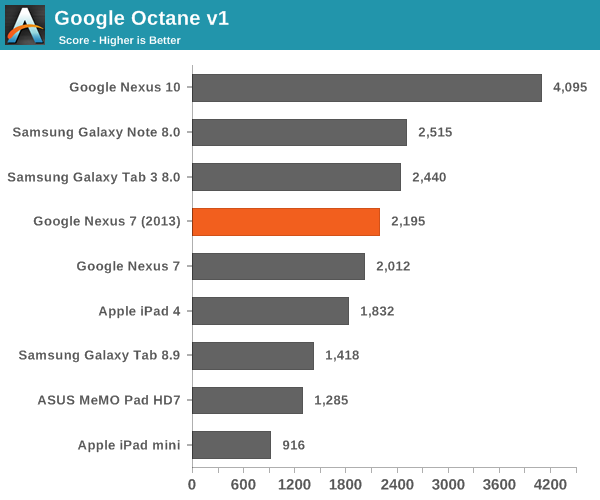


The GPU
Qualcomm seems to be frequency binning here, which is standard industry practice. Using binning to create these different SKUs gives Qualcomm pricing flexibility and also gives it the option to give large customers special treatment.
On the graphics side Qualcomm's Adreno 320 GPU makes an appearance. Clock speeds are also limited to 400MHz, compared to 450MHz for the high-end Snapdragon 600 implementations we've seen.
The APQ8064-1AA's dual-channel memory controller is populated with four x 16-bit DDR3L-1600 memory devices, giving the Nexus 7 a healthy amount of memory bandwidth. Peak memory bandwidth available to the APQ8064-1AA is 12.8GB/s, equalling what's available to Apple's A5X in the 3rd generation iPad with Retina display. Tons of memory bandwidth is obviously a pre-requisite for driving a high resolution display, and the combination of DDR3L-1600 and the Adreno 320 GPU delivers a butter smooth UI in all well written Android apps.
Although CPU performance is somewhat middle of the road compared to the rest of the landscape, GPU performance is faster than any other Nexus device on the market - and pretty much faster than any other similarly sized tablet:
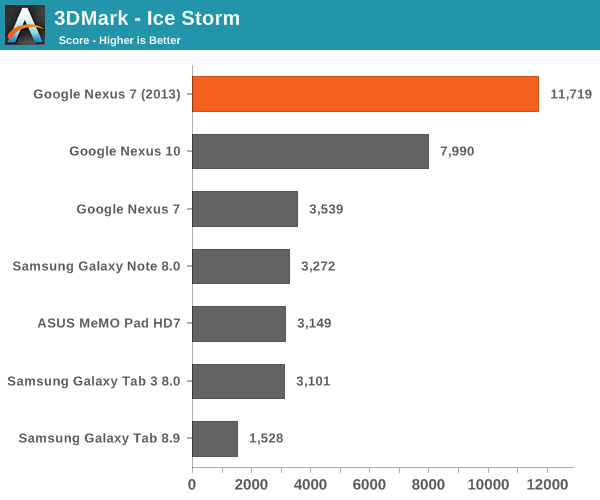
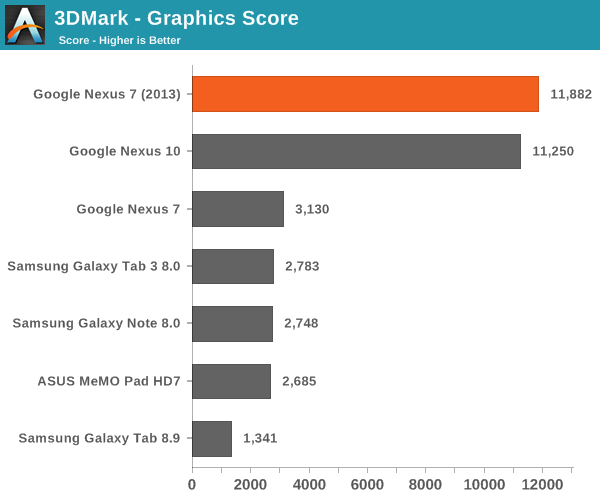
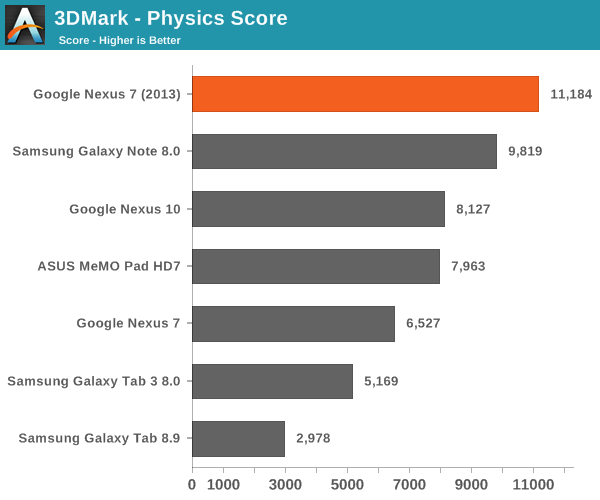
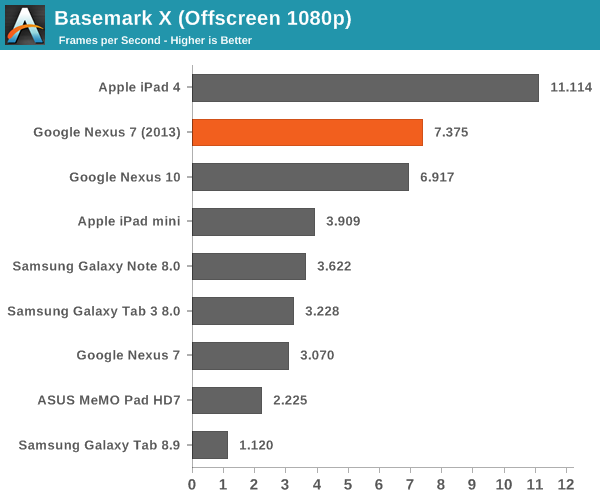
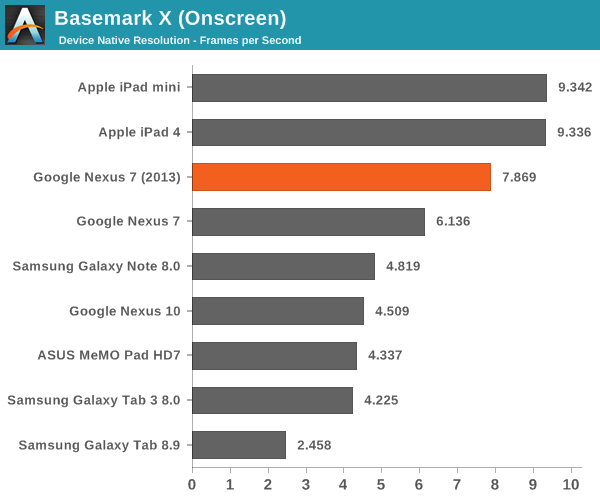
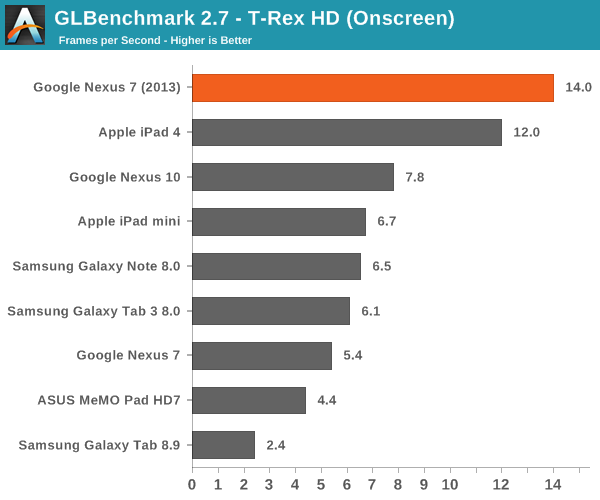
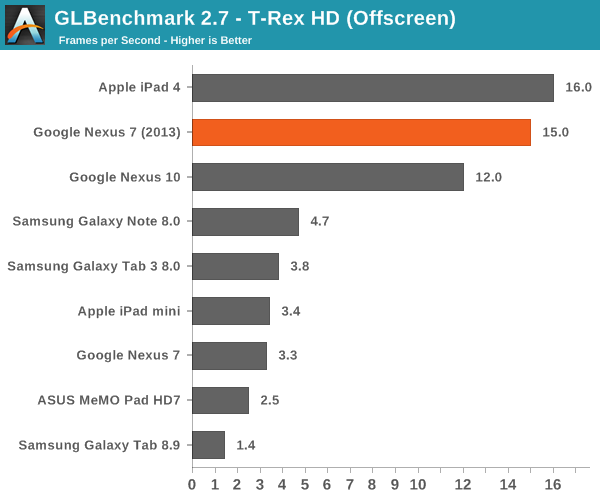
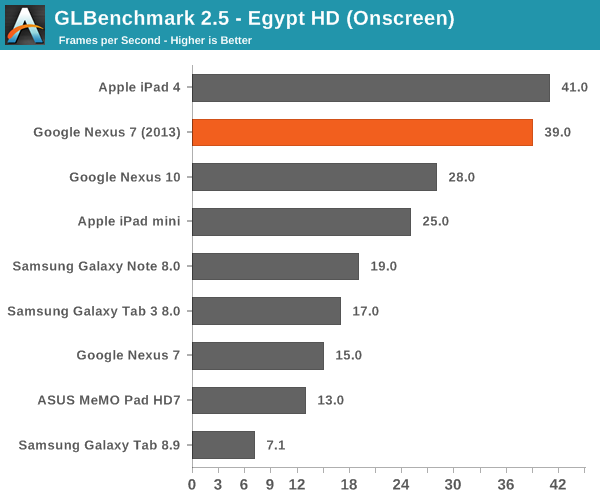
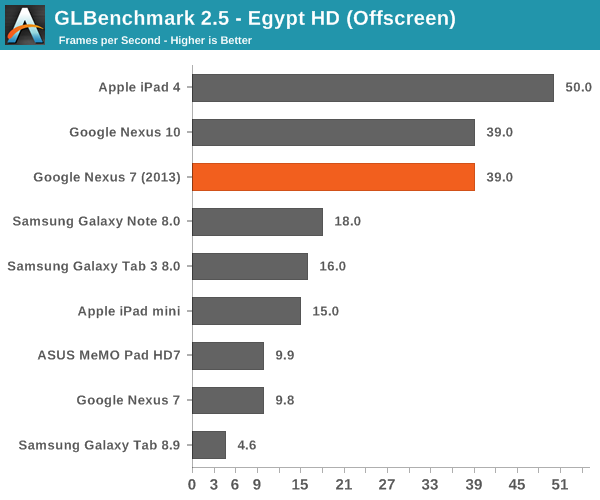
I played Modern Combat 4 as well as Shadowgun, both demanding 3D titles, on the new Nexus 7. Both titles appeared to render at the Nexus 7's native 1920 x 1200 resolution, and both appeared to do so at around 30 fps.


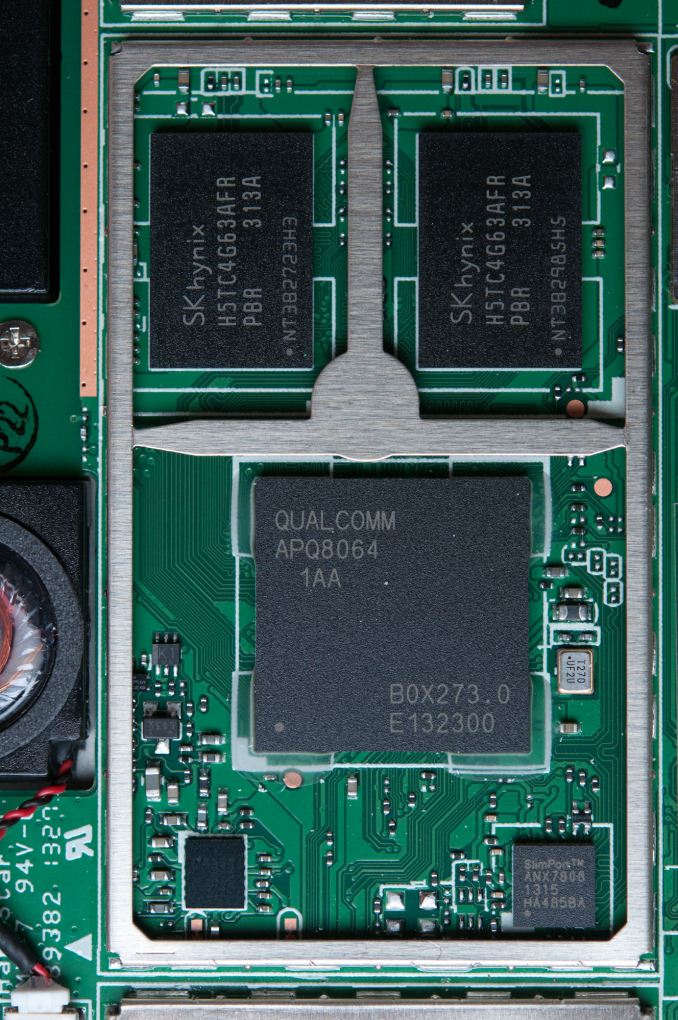
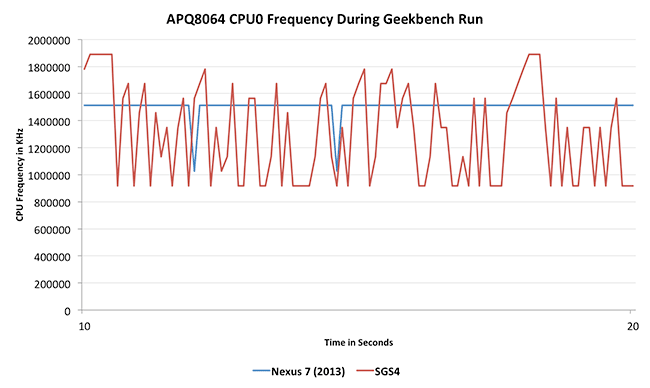
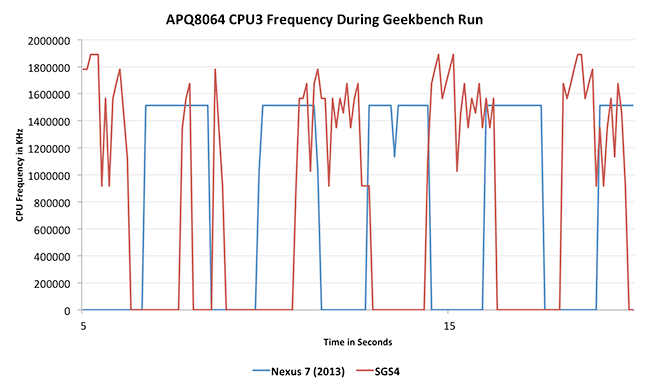








202 Comments
View All Comments
JDG1980 - Thursday, August 22, 2013 - link
This is Anandtech, not the Wall Street Journal. Why are the business strategies of these companies relevant to who provides the best device at the best price? Why should consumers care who is subsidizing what?BMNify - Thursday, August 22, 2013 - link
Copy pasting from my above comment as you didn't go through it: If subsidised hardware kill off the hardware manufacturer's then you will be left with a monopoly that is Google who can charge you more later and make money on Ad's too like they do now. This is the reason why selling at-cost or dumping is not desirable.smartypnt4 - Thursday, August 22, 2013 - link
Interesting perspective. I hadn't heard a well-reasoned argument against selling at or near cost before now. Also, do you have a source to back up the claim that ASUS is making a significantly smaller margin on the N7 than they are on their other devices? Their MemoPad HD 7 is a 2012 N7 clone that's $150, so if the 2013 N7 is at cost, that has to be as well. And that's not being subsidized by Google, so if it were really at cost without some hypothetical Google subsidy, why would ASUS bother designing and selling it?psyside1 - Friday, August 23, 2013 - link
Thanks alot Anand, for listening us, and put the 16 vs 32GB version in your review, now i know i want the 32GB version! fanstastic review.ASEdouardD - Friday, August 23, 2013 - link
I know it's a great thing to add in the review, but I would frankly would have preferred not to know! As I bought the 16 GB model, hehe. Doubt it has a big impact on real world use though.akdj - Sunday, August 25, 2013 - link
Google most likely pays ASUS to make the tablet....they pay the price of the BOM & labor directly to ASUS. That's how they are making their money. Google is essentially giving the tablet away for you, and everything that IS you. Your friends. Your contacts. Your email. Your documents and music and movies....and, what they call the 'data mine'. They sell that info to third party companies and probably double their original $200 investment to ASUSsmartypnt4 - Sunday, August 25, 2013 - link
According to what evidence? It's widely known that Apple takes a very large margin on their products, which the Mini being the lowest margin (~40% if I remember correctly). There has been no indication of what the Nexus 7 actually costs to build. My point is that ASUS is selling their own tablets without Google at prices that make me think that the Nexus 7 isn't actually being sold at or under cost. I'm thinking it's probably relatively low-margin compared to the iOS devices, but everything in technology is low margin compared to iOS stuff (except Intel processors, that is).And yes, Google uses your information to target ads at you. That's not really news to anyone, and anyone buying into Android better know and be OK with that, or just not care.
amdwilliam1985 - Monday, August 26, 2013 - link
Thanks for the insight info about Google spying on us. Let's run the other way, Apple/M$ are so great and never touch our private sensitive data. Our data sitting in icloud/skydrive are so magical that nothing comes and tint it. Oh just how I love facebook is doing everything they can to make us feeling safer/happier about posting everything onto it. man oh man, the 21st century is all about Google mining your/our data and every other companies protecting you/us ;) /sSarcastic off, man grow up, crying about Google spying on you, lol. The way I see it is that if they're going to data mine us one way or the other, why not benefit from it? Why pay for your device twice? Once in privacy and once in physical dollar. I'm going with the one that I think is the least evil of them all, Google. Yes, I've used apple products before, didn't like how restricted iphone/ipad are. Didn't like how macbook air can't install the programs that are only running in windows, sigh...
Mivo - Friday, August 23, 2013 - link
You should probably post some sources for your claims. That aside, what is and is not desireable is a matter of perspective. I'd wager that most end customers are fine with ads or a walled garden, if that substantially lowers the price of a device. Just look at Amazon and their customers. (Or look at Apple and their customers who happily pay premium prices in spite of the walled garden.)Ananke - Friday, August 23, 2013 - link
Example: Asus buys from Foxconn at $220, and sells for $229. If it costs Foxconn 29.99 to manufacture and sell to Asus, is it considered "sold almost at cost" to end users by your logic?